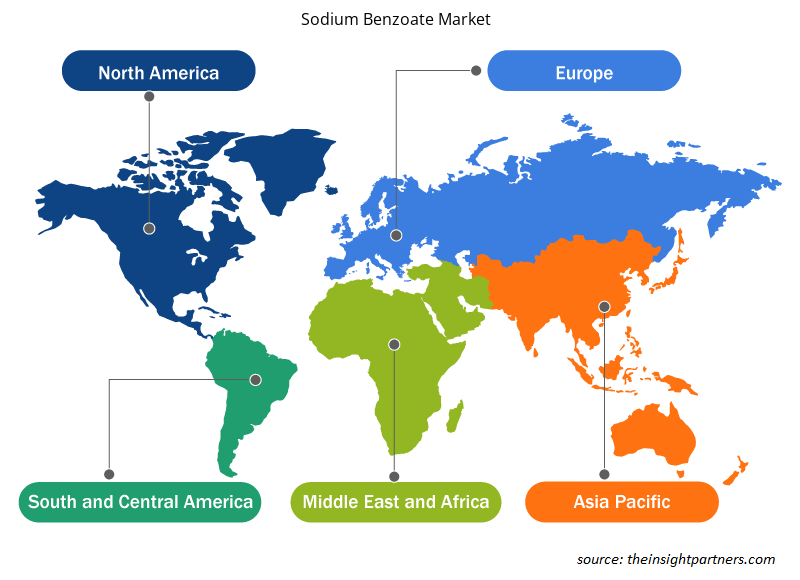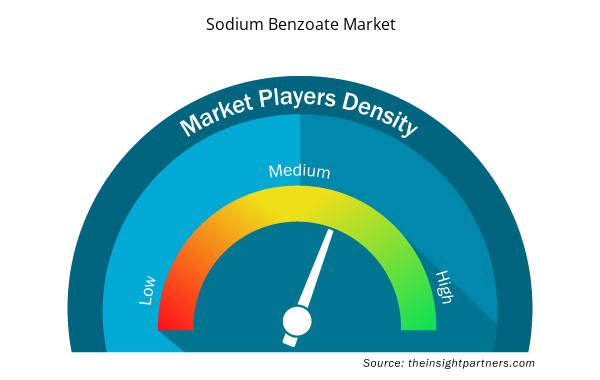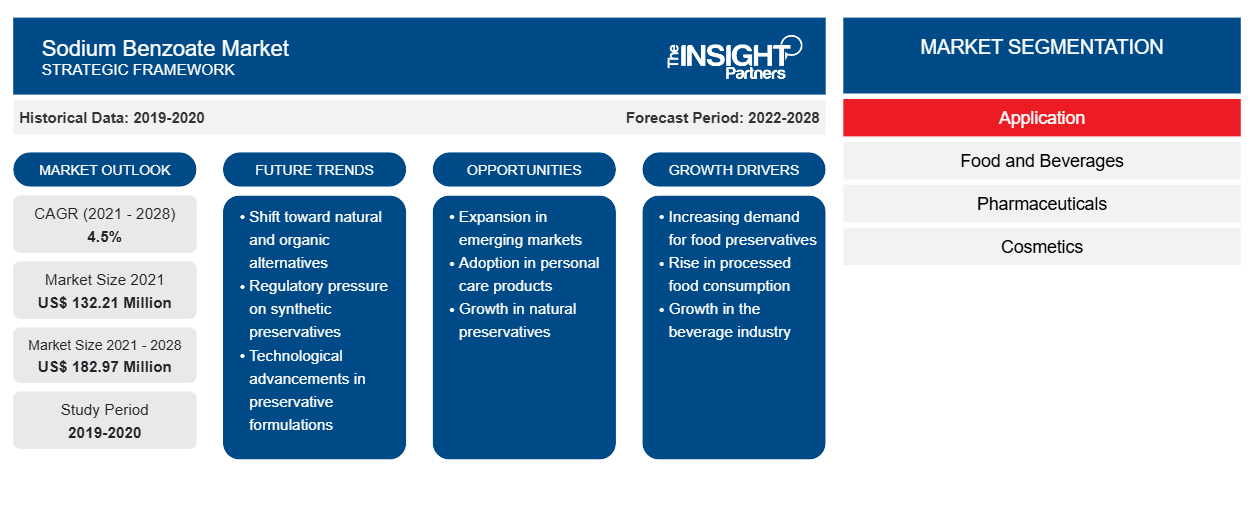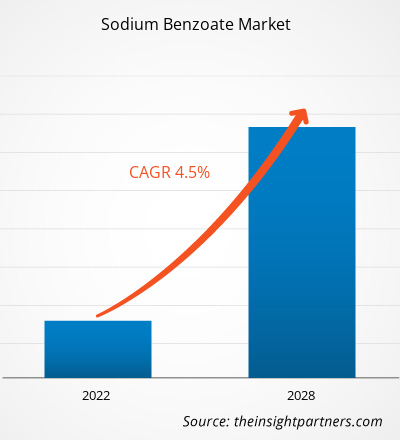[Rapporto di ricerca] Si prevede che il mercato del benzoato di sodio raggiungerà 182.965,2 mila dollari entro il 2028, rispetto ai 132.214,6 mila dollari del 2021; si prevede che crescerà a un CAGR del 4,5% nel periodo 2021-2028.
C'è un aumento della domanda di conservanti in vari settori di utilizzo finale come alimenti e bevande, cosmetici, cura dei tessuti e prodotti farmaceutici, che aumenta ulteriormente la necessità di benzoato di sodio . La crescente domanda di conservanti per migliorare la durata di conservazione dei diversi prodotti alimentari contribuisce alla forte domanda di benzoato di sodio nel settore alimentare e delle bevande. Inoltre, la crescente domanda di prodotti cosmetici nel mondo sta spingendo la crescita del mercato del benzoato di sodio . C'è un'elevata domanda di conservanti nel settore cosmetico per migliorare la qualità del prodotto e aumentarne la durata di conservazione, il che dovrebbe alimentare la necessità di benzoato di sodio . Le aziende cosmetiche hanno continuato ad aumentare le quote di mercato in tutto il mondo, soprattutto nei paesi emergenti. Ad esempio, secondo il rapporto della Federation of Beauty Companies ( FEBEA ), i guadagni delle esportazioni di cosmetici francesi sono stati di 18,1 miliardi di dollari nel 2021, con un aumento del 2,5% rispetto al 2019. I fattori sopra menzionati stanno guidando la domanda di benzoato di sodio .
Nel 2020, l'Asia Pacifica ha detenuto la quota maggiore del mercato globale del benzoato di sodio e si stima che registrerà il CAGR più elevato nel mercato durante il periodo di previsione. L'APAC comprende Cina, India, Giappone, Australia, Corea del Sud e il resto dell'APAC . I paesi dell'APAC come Cina e India sono tra le popolazioni in più rapida crescita. I settori automobilistico, dell'imballaggio, dell'edilizia, della cura della persona e alimentare e delle bevande si stanno sviluppando rapidamente nell'APAC con la popolazione in crescita. Settori consolidati come alimentare e delle bevande, cosmetici, cura della persona e farmaceutica hanno aumentato la domanda di benzoato di sodio nella regione.
Personalizza questo report in base alle tue esigenze
Riceverai la personalizzazione gratuita di qualsiasi report, comprese parti di questo report, o analisi a livello nazionale, pacchetto dati Excel, oltre a usufruire di grandi offerte e sconti per start-up e università
- Scopri le principali tendenze di mercato in questo rapporto.Questo campione GRATUITO includerà analisi di dati che spaziano dalle tendenze di mercato alle stime e alle previsioni.
Impatto della pandemia di COVID-19 sul mercato del benzoato di sodio
La pandemia di COVID-19 ha avuto un impatto misto sul mercato del benzoato di sodio . Inizialmente, il COVID-19 ha avuto un impatto sostanziale sul mercato a causa della diminuzione della produzione. L'imposizione di misure di blocco ha comportato l'interruzione delle operazioni di produzione, con conseguente diminuzione delle attività di fornitura. Inoltre, le restrizioni di viaggio in tutto il mondo hanno reso difficile il trasporto delle materie prime, il che ha frenato la crescita dell'economia globale. Tuttavia, si prevede che la pandemia di COVID-19 avrà un effetto favorevole a lungo termine sul mercato nei prossimi anni. Lo scoppio ha portato all'aumento degli alimenti confezionati poiché i consumatori sono diventati sempre più consapevoli dell'igiene e della sicurezza dei prodotti e quindi hanno preferito acquistare alimenti con imballaggi sicuri. Poiché il benzoato di sodio è utilizzato come conservante in molti alimenti confezionati, la crescita della produzione di alimenti confezionati ha favorito il mercato. Inoltre, a causa dell'impatto improvviso della pandemia, il mercato ha visto un boom nella domanda di prodotti che supportano il rafforzamento dell'immunità nel settore farmaceutico e nutraceutico . Il settore farmaceutico è uno dei principali settori applicativi per il mercato del benzoato di sodio. Di conseguenza, anche il consumo di benzoato di sodio è aumentato vertiginosamente. Inoltre, per rispondere a questa crescente domanda di questi integratori, i produttori hanno reindirizzato i loro sforzi verso il miglioramento delle loro strategie di vendita e la spinta del prodotto verso mercati inesplorati.
Approfondimenti di mercato
Crescente domanda di benzoato di sodio nel settore alimentare e delle bevande
Il benzoato di sodio è il sale sodico dell'acido benzoico . È ampiamente utilizzato come conservante alimentare e agente di decapaggio nell'industria alimentare e delle bevande. È generalmente riconosciuto come sicuro dalla Food and Drug Administration (FDA) e consente una concentrazione fino allo 0,1% in peso quando utilizzato negli alimenti. Il benzoato di sodio è utilizzato in alimenti acidi come condimenti per insalata, bevande gassate, sottaceti, marmellate e succhi di frutta, condimenti e guarnizioni per yogurt gelato per prevenire il deterioramento causato da microrganismi nocivi come batteri nocivi, lieviti e muffe. Aiuta anche a mantenere la freschezza degli alimenti rallentando o prevenendo cambiamenti di colore, sapore, pH e consistenza. Inoltre, agisce come conservante batteriostatico e fungistatico nelle bevande analcoliche e in altre bevande, il che aumenta il sapore acido e prolunga la durata di conservazione del prodotto. Il benzoato di sodio è comunemente utilizzato come conservante per proteggere il gusto. La Coca-Cola Company lo utilizza anche come agente antimicrobico nelle bevande Coca-Cola.
Approfondimenti sulle applicazioni
In base all'applicazione, il mercato globale del benzoato di sodio è segmentato in alimenti e bevande, prodotti farmaceutici, cosmetici, agricoltura e altri. Nel 2020, il segmento degli alimenti e delle bevande ha rappresentato la quota di fatturato maggiore. La domanda di benzoato di sodio sta aumentando notevolmente nel settore degli alimenti e delle bevande a causa dei cambiamenti nelle preferenze dei clienti per alimenti e bevande confezionati e del reddito pro capite più elevato. In molti paesi, la crescente tendenza a saltare i pasti, come la colazione, ha portato a un aumento della domanda dei consumatori di prodotti alimentari e bevande trasformati e confezionati.
Eastman Chemical Company; Foodchem International Corporation; AM FOOD CHEMICAL CO., LIMITED; Jarchem Innovative Ingredients LLC; MERCK KGaA; LANXESS; Akema Srl; Zancheng Life Sciences Ltd.; FBC Industries; e Reagents sono tra i principali attori che operano nel mercato. Queste aziende forniscono un'ampia gamma di portafogli di prodotti per il mercato. Le aziende sono presenti nelle regioni in via di sviluppo, il che offre opportunità redditizie per la crescita del mercato. Gli attori del mercato stanno sviluppando prodotti innovativi e di alta qualità per soddisfare le esigenze dei clienti.
Approfondimenti regionali sul mercato del benzoato di sodio
Le tendenze regionali e i fattori che influenzano il mercato del benzoato di sodio durante il periodo di previsione sono stati ampiamente spiegati dagli analisti di Insight Partners. Questa sezione discute anche i segmenti e la geografia del mercato del benzoato di sodio in Nord America, Europa, Asia Pacifico, Medio Oriente e Africa e America meridionale e centrale.

- Ottieni i dati specifici regionali per il mercato del benzoato di sodio
Ambito del rapporto di mercato del benzoato di sodio
| Attributo del report | Dettagli |
|---|---|
| Dimensioni del mercato nel 2021 | 132,21 milioni di dollari USA |
| Dimensioni del mercato entro il 2028 | 182,97 milioni di dollari USA |
| CAGR globale (2021 - 2028) | 4,5% |
| Dati storici | 2019-2020 |
| Periodo di previsione | 2022-2028 |
| Segmenti coperti | Per applicazione
|
| Regioni e Paesi coperti | America del Nord
|
| Leader di mercato e profili aziendali chiave |
|
Densità degli attori del mercato del benzoato di sodio: comprendere il suo impatto sulle dinamiche aziendaliBenzoate Market Players Density: Understanding Its Impact on Business Dynamics
Il mercato del benzoato di sodio sta crescendo rapidamente, spinto dalla crescente domanda degli utenti finali dovuta a fattori quali l'evoluzione delle preferenze dei consumatori, i progressi tecnologici e una maggiore consapevolezza dei benefici del prodotto. Con l'aumento della domanda, le aziende stanno ampliando le loro offerte, innovando per soddisfare le esigenze dei consumatori e capitalizzando sulle tendenze emergenti, il che alimenta ulteriormente la crescita del mercato.Benzoate Market market is growing rapidly, driven by increasing end-user demand due to factors such as evolving consumer preferences, technological advancements, and greater awareness of the product's benefits. As demand rises, businesses are expanding their offerings, innovating to meet consumer needs, and capitalizing on emerging trends, which further fuels market growth.
La densità degli operatori di mercato si riferisce alla distribuzione di aziende o società che operano in un particolare mercato o settore. Indica quanti concorrenti (operatori di mercato) sono presenti in un dato spazio di mercato in relazione alle sue dimensioni o al valore di mercato totale.
Le principali aziende che operano nel mercato del benzoato di sodio sono:Benzoate Market are:
- Società chimica Eastman
- Società internazionale Foodchem
- AM FOOD CHEMICAL CO., LIMITATA
- Ingredienti innovativi Jarchem LLC
- Merck KGaA
Disclaimer : le aziende elencate sopra non sono classificate secondo un ordine particolare.

- Ottieni una panoramica dei principali attori del mercato del benzoato di sodioBenzoate Market top key players overview
Segnala i riflettori
- Tendenze industriali progressive nel mercato del benzoato di sodio per aiutare gli operatori a sviluppare strategie efficaci a lungo terminebenzoate market to help players develop effective long-term strategies
- Strategie di crescita aziendale adottate dai mercati sviluppati e in via di sviluppo
- Analisi quantitativa del mercato del benzoato di sodio dal 2019 al 2028benzoate market from 2019 to 2028
- Stima della domanda globale di benzoato di sodiobenzoate
- Analisi delle cinque forze di Porter per illustrare l'efficacia degli acquirenti e dei fornitori che operano nel settore
- Sviluppi recenti per comprendere lo scenario competitivo del mercato
- Tendenze e prospettive di mercato, nonché fattori che guidano e frenano la crescita del mercato del benzoato di sodiobenzoate market
- Assistenza nel processo decisionale evidenziando le strategie di mercato che sostengono l'interesse commerciale, portando alla crescita del mercato
- La dimensione del mercato del benzoato di sodio in vari nodi
- Panoramica dettagliata e segmentazione del mercato, nonché dinamiche del settore del benzoato di sodio
- Dimensioni del mercato del benzoato di sodio in varie regioni con promettenti opportunità di crescita
"Global Sodium Benzoate Market Analysis to 2028" è uno studio specializzato e approfondito del settore chimico e dei materiali con un'attenzione particolare all'analisi delle tendenze del mercato globale del benzoato di sodio. Il rapporto mira a fornire una panoramica del mercato con una segmentazione dettagliata del mercato. Il mercato del benzoato di sodio è segmentato in base all'applicazione e alla geografia. Per applicazione, il mercato del benzoato di sodio è segmentato in alimenti e bevande, prodotti farmaceutici, cosmetici, agricoltura e altri. Per geografia, il mercato è ampiamente segmentato in Nord America, Europa, Asia Pacifico (APAC), Medio Oriente e Africa (MEA) e Sud e Centro America.
Profili aziendali:
- Società chimica Eastman
- Foodchem International Corporation
- AM FOOD CHEMICAL CO., LIMITATA
- Ingredienti innovativi Jarchem LLC
- Merck KGaA
- LANXESS
- Akema Srl
- Azienda
- Industrie FBC
- Reagenti
- Analisi storica (2 anni), anno base, previsione (7 anni) con CAGR
- Analisi PEST e SWOT
- Valore/volume delle dimensioni del mercato - Globale, regionale, nazionale
- Industria e panorama competitivo
- Set di dati Excel



Report Coverage
Revenue forecast, Company Analysis, Industry landscape, Growth factors, and Trends

Segment Covered
This text is related
to segments covered.

Regional Scope
North America, Europe, Asia Pacific, Middle East & Africa, South & Central America

Country Scope
This text is related
to country scope.
Domande frequenti
Asia Pacific is estimated to register the fastest CAGR in the global sodium benzoate market over the forecast period. The growth of the sodium benzoate market in Asia-Pacific is driven by rising demand for sodium benzoate from various end-use industries such as cosmetics, food and beverages, pharmaceuticals, and automotive.
The cosmetic segment is the fastest growing segment in the global sodium benzoate market during the forecasted period. Sodium benzoate is used as a preservative in cosmetics and personal care products due to its antimicrobial and antifungal. Furthermore, the demand for halal cosmetics is rising, which is expected to build a proper base for the growing preservatives market.
The pharmaceutical segment holds the attractive opportunities during the forecast period. Sodium benzoate is often used as a preservative in liquid medicines, such as cough syrup. It also finds application as an antimicrobial preservative, antifungal, and lubricant for tablets and capsules.
The food and beverage segment held the largest market share. Sodium benzoate is used as preservative in packaged food. The food & beverage industry is mostly dominated by the packaged food. A change in culinary style with rise in consumption of ready-to-eat products increased the demand for packaged foods across the globe.
In 2021, Asia Pacific held the largest share of the global sodium benzoate market. China and India are the two leading producers of sodium benzoate across the world. In India, the sodium benzoate production industry is among the fastest-growing ones. The growing urbanization in this region, coupled with rise in demand for packaged food and cosmetics, has fueled the consumption of sodium benzoate extensively.
The major players operating in the global sodium benzoate market are Eastman Chemical Company; Foodchem International Corporation; A.M FOOD CHEMICAL CO., LIMITED; Jarchem Innovative Ingredients LLC; MERCK KGaA; LANXESS; Akema S.r.l.; Zancheng Life Sciences Ltd.; FBC Industries; and Reagents.
Trends and growth analysis reports related to Chemicals and Materials : READ MORE..
The List of Companies - Sodium Benzoate Market
- Eastman Chemical Company
- Foodchem International Corporation
- A.M FOOD CHEMICAL CO., LIMITED
- Jarchem Innovative Ingredients LLC
- MERCK KGaA
- LANXESS
- Akema S.r.l.
- Zancheng Life Sciences Ltd.
- FBC Industries
- Reagents
The Insight Partners performs research in 4 major stages: Data Collection & Secondary Research, Primary Research, Data Analysis and Data Triangulation & Final Review.
- Data Collection and Secondary Research:
As a market research and consulting firm operating from a decade, we have published and advised several client across the globe. First step for any study will start with an assessment of currently available data and insights from existing reports. Further, historical and current market information is collected from Investor Presentations, Annual Reports, SEC Filings, etc., and other information related to company’s performance and market positioning are gathered from Paid Databases (Factiva, Hoovers, and Reuters) and various other publications available in public domain.
Several associations trade associates, technical forums, institutes, societies and organization are accessed to gain technical as well as market related insights through their publications such as research papers, blogs and press releases related to the studies are referred to get cues about the market. Further, white papers, journals, magazines, and other news articles published in last 3 years are scrutinized and analyzed to understand the current market trends.
- Primary Research:
The primarily interview analysis comprise of data obtained from industry participants interview and answers to survey questions gathered by in-house primary team.
For primary research, interviews are conducted with industry experts/CEOs/Marketing Managers/VPs/Subject Matter Experts from both demand and supply side to get a 360-degree view of the market. The primary team conducts several interviews based on the complexity of the markets to understand the various market trends and dynamics which makes research more credible and precise.
A typical research interview fulfils the following functions:
- Provides first-hand information on the market size, market trends, growth trends, competitive landscape, and outlook
- Validates and strengthens in-house secondary research findings
- Develops the analysis team’s expertise and market understanding
Primary research involves email interactions and telephone interviews for each market, category, segment, and sub-segment across geographies. The participants who typically take part in such a process include, but are not limited to:
- Industry participants: VPs, business development managers, market intelligence managers and national sales managers
- Outside experts: Valuation experts, research analysts and key opinion leaders specializing in the electronics and semiconductor industry.
Below is the breakup of our primary respondents by company, designation, and region:

Once we receive the confirmation from primary research sources or primary respondents, we finalize the base year market estimation and forecast the data as per the macroeconomic and microeconomic factors assessed during data collection.
- Data Analysis:
Once data is validated through both secondary as well as primary respondents, we finalize the market estimations by hypothesis formulation and factor analysis at regional and country level.
- Macro-Economic Factor Analysis:
We analyse macroeconomic indicators such the gross domestic product (GDP), increase in the demand for goods and services across industries, technological advancement, regional economic growth, governmental policies, the influence of COVID-19, PEST analysis, and other aspects. This analysis aids in setting benchmarks for various nations/regions and approximating market splits. Additionally, the general trend of the aforementioned components aid in determining the market's development possibilities.
- Country Level Data:
Various factors that are especially aligned to the country are taken into account to determine the market size for a certain area and country, including the presence of vendors, such as headquarters and offices, the country's GDP, demand patterns, and industry growth. To comprehend the market dynamics for the nation, a number of growth variables, inhibitors, application areas, and current market trends are researched. The aforementioned elements aid in determining the country's overall market's growth potential.
- Company Profile:
The “Table of Contents” is formulated by listing and analyzing more than 25 - 30 companies operating in the market ecosystem across geographies. However, we profile only 10 companies as a standard practice in our syndicate reports. These 10 companies comprise leading, emerging, and regional players. Nonetheless, our analysis is not restricted to the 10 listed companies, we also analyze other companies present in the market to develop a holistic view and understand the prevailing trends. The “Company Profiles” section in the report covers key facts, business description, products & services, financial information, SWOT analysis, and key developments. The financial information presented is extracted from the annual reports and official documents of the publicly listed companies. Upon collecting the information for the sections of respective companies, we verify them via various primary sources and then compile the data in respective company profiles. The company level information helps us in deriving the base number as well as in forecasting the market size.
- Developing Base Number:
Aggregation of sales statistics (2020-2022) and macro-economic factor, and other secondary and primary research insights are utilized to arrive at base number and related market shares for 2022. The data gaps are identified in this step and relevant market data is analyzed, collected from paid primary interviews or databases. On finalizing the base year market size, forecasts are developed on the basis of macro-economic, industry and market growth factors and company level analysis.
- Data Triangulation and Final Review:
The market findings and base year market size calculations are validated from supply as well as demand side. Demand side validations are based on macro-economic factor analysis and benchmarks for respective regions and countries. In case of supply side validations, revenues of major companies are estimated (in case not available) based on industry benchmark, approximate number of employees, product portfolio, and primary interviews revenues are gathered. Further revenue from target product/service segment is assessed to avoid overshooting of market statistics. In case of heavy deviations between supply and demand side values, all thes steps are repeated to achieve synchronization.
We follow an iterative model, wherein we share our research findings with Subject Matter Experts (SME’s) and Key Opinion Leaders (KOLs) until consensus view of the market is not formulated – this model negates any drastic deviation in the opinions of experts. Only validated and universally acceptable research findings are quoted in our reports.
We have important check points that we use to validate our research findings – which we call – data triangulation, where we validate the information, we generate from secondary sources with primary interviews and then we re-validate with our internal data bases and Subject matter experts. This comprehensive model enables us to deliver high quality, reliable data in shortest possible time.


 Ottieni un campione gratuito per questo repot
Ottieni un campione gratuito per questo repot